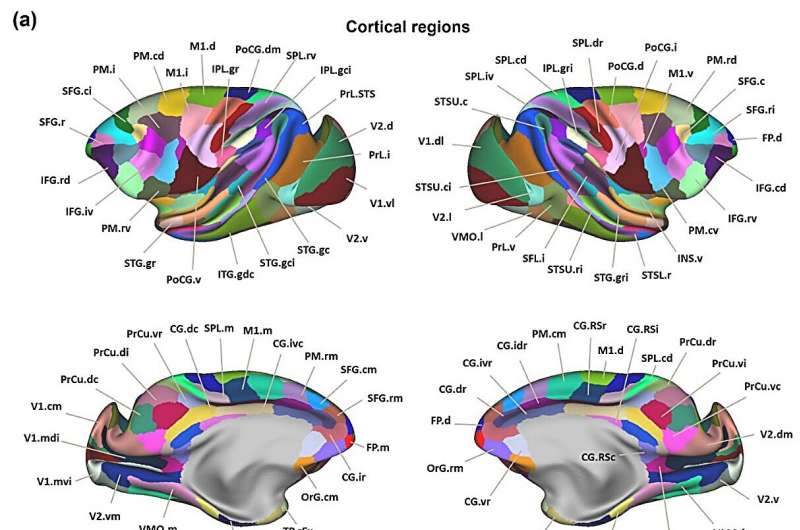(a) 248 cortical subregions and (b) 56 subcortical subregions of Macaque Brainnetome Atlas. Credit: Science China Press
As an ideal model for studying human cognitive function and brain diseases, macaques are highly similar to humans in genetics, physiology, and brain structure. Currently, non-human primates are considered as a core source for exploring cognitive neural mechanisms and promoting translational medicine. Therefore, a multifaced brain atlas elucidating the architecture of the macaque brain is of great significance for translating research findings from macaques to humans.
Such an atlas can characterize profiles of whole-brain regions, including connectivity, anatomy, and geometric topology, aiding in our understanding of brain function, development, and evolution. However, existing atlas have primarily focused on fragmented regions and single-modal data, while comprehensive macaque brain atlases have been challenging to achieve.
Recently, the research team led by Dr. Tianzi Jiang at the Brainnetome center of the Institute of Automation, Chinese Academy of Sciences delineated a multifaced macaque brain atlas, Macaque Brainnetome Atlas (MacBNA). MacBNA not only provides fine-grained parcellation of brain regions but also describes the macroscopic connections between subregions. The study is published in the journal Science Bulletin.
Serving as a reliable reference system, it can effectively integrate multi-scale brain images and multi-omics data, thus delineating a multi-modal, cross-scale atlas of the macaque brain. Macaque Brainnetome Atlas, as a multifaced brain atlas depicting the architecture of the macaque brain, will overcome many limitations of existing atlases, including focusing solely on specific anatomical regions or single-modal information.
Additionally, brainnetome atlases of both humans and macaques constructed using the same method will play a crucial role in effectively transferring information and knowledge acquired from monkey brains to human brains.
In addition, the multi-modal multi-scale dataset in this study will also provide an open-access platform for addressing computational issues, such as establishing macaque digital twin brains and cross-scale image registration. Researchers are currently continuing to collect data to further enrich MacBNA.
Furthermore, the principles and methods of brain network atlas construction have the potential to extend to comparative studies in other species. Therefore, they anticipate that MacBNA and its related multimodal multi-scale resources will play a crucial role in cross-species comparisons, translational medicine, and computational modeling.
The development of brainnetome atlases will evolve towards cross-species brain atlases and multimodal multi-scale brain atlases, providing a solid foundation for diagnosis, treatment, cross-species research, and inspiration for neuromorphic intelligence.
This study is led by Prof. Tianzi Jiang (Brainnetome center of the Institute of Automation, Chinese Academy of Sciences), Prof. Lingzhong Fan (Brainnetome center of the Institute of Automation, Chinese Academy of Sciences), and Prof. Zhengyi Yang (Brainnetome center of the Institute of Automation, Chinese Academy of Sciences).
More information: Yuheng Lu et al, Macaque Brainnetome Atlas: A multifaceted brain map with parcellation, connection, and histology, Science Bulletin (2024). DOI: 10.1016/j.scib.2024.03.031
Provided by Science China Press
























